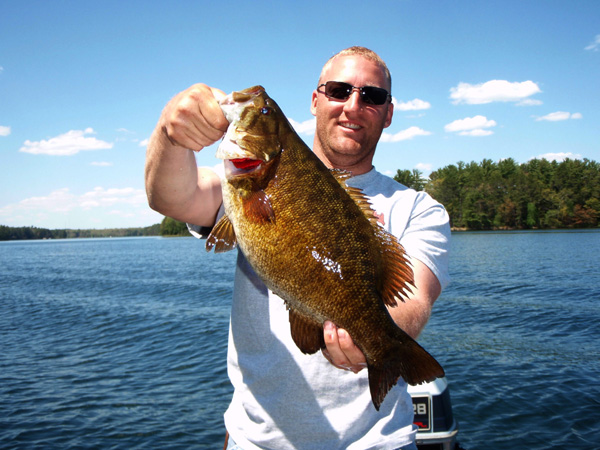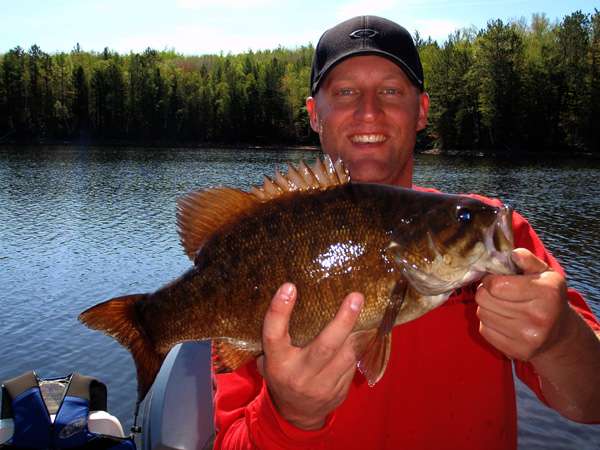Imagine the quality of fishing in Northern Wisconsin. Probably the first ideas coming to mind are its legendary world record muskies, and the thoughts of walleyes sizzling on the frying pan.
Although muskies and walleyes aren’t my most frequently fished quarries up north, I still spend significant amounts of time each year catching them like the locals do. While these two gamefish species are the most pursued and popular amongst Wisconsin anglers, another prominent fish species is usually overlooked and far too often ignored.
Wisconsin is a great state for catching smallmouth bass. In fact, it’s even better for catching giant smallmouth bass during the spring season. Illinoisans are significantly limited to a handful of productive rivers and streams, and only a few select lakes that are sustained through stocking. We are privileged enough to have neighbors to our north that have healthy fisheries that are home to tremendous populations of big fish. Best of all, several of them are within reasonable traveling distances, with enough class to offer worthwhile fishing getaways.

There are literally hundreds of lakes and rivers to fish where big smallmouth bass can be caught. If you want to catch some of the biggest and most exciting fish of the year, head north of highway 10 to where the lakes are clear and the fish run big
Springtime offers eager anglers something so great that it can only be experienced once each year during a six week long specially-regulated season. For me, personally, this is a six week bass fishing holiday. From opening weekend of May through the third Saturday of June, Wisconsin has a mandatory catch and release spring season on bass. These regulations were first established in the mid-1980’s to protect the vulnerable and spawning fish populations. During this period, some of the largest fish of the season are caught and released, and enjoyed by conservation-minded trophy hunters who fish purely for the sport and love of the game.
Who wouldn’t want to catch four, five, and six pound smallmouth bass in a repetitive fashion as if it were a video game?

There are over 2,300 different lakes to choose from in the region I fish in Oneida, Vilas, and Iron counties. Although having a lifetime of fishing destinations and opportunities within a 50 mile radius is troubling for folks who operate with limited schedules, what makes this area special is that there are too many good places to fish in such little time.
Since my youth, I have fished hundreds of lakes containing smallmouth bass. Nearly all of these places have differed in terms of size (acreage), growth rates, and fishery.
Although good populations of fish are present in most places, some of the best lakes I fish possess a number of variables, enabling them to contain fine smallmouth bass fisheries that consistently produce big fish year after year.
Nearly every productive smallmouth lake I’ve fished contains clear to moderately stained cola-brown water, and features a habitat comprised of sand, rock, gravel, wood, and some weedgrowth that is mostly occupied by baitfish and other juvenile species.

First and foremost, smallmouth bass usually relate to certain areas of the lake as opposed to others due to the forage factor. Big fish reach their sizes for a reason; they gorge themselves on what is available in front of them. The best lakes are late oligotrophic to mid-mesotrophic, are fertile, and contain a diverse fishery of both predator and prey species. Most lakes are home to crayfish, and some lakes are more abundant with them than others due to infestations of non-native rusty crayfish. In my opinion, the more native and rusty crayfish available, the better the quality of fishing is. However, it is important to note that the best smallmouth bass lakes are ones that contain both crayfish and pelagic baitfish species that includes shiners, smelt, juvenile ciscoes, and even yellow perch. In any healthy smallmouth bass fishery, the lake better have a full fridge, as it takes a number of available forage options to rear big fish in large numbers.
Traditional smallmouth lakes offer deep and cool water. However, the best lakes contain depths of everything from shallow to deep, and somewhere in between.
Some of the most incredible bodies of water I have ever launched my boat at possess a maze of transitions from shallow to deep water and underwater contour. Such examples are shelves, drop-offs, rock bars, sand bars, sunken islands, trenches, and fields of boulders. Any time you are faced with a lake offering all of this, it will be a smallie paradise. In my opinion, lakes offering too many specific spots to fish in one single day are the places worth spending your most time at.
Although smallmouths are present in most lakes containing the aforementioned variables, big water and lakes larger than 1,000 surface acres are places that will usually contain the bigger fish along with substantial numbers of them too. As opposed to smaller lakes, 50 to 200 acres, that might not receive as much angling pressure, lake size and available habitat are the deterring factors that limit the number of big fish being present. One of the most common axioms in fishing is that big water grows an abundance of big fish. In the case of smallmouth bass, this goes undisputed
Once you have your lake selections made and defined fish locations figured out, it’s time to enjoy the six weeks of spring.

The North Country spring season is defined by stereotypical winter weather that, without any pauses, rapidly turns into summertime heat. Quickly, within a few short weeks beginning the first week of May, the 40 degree water temperatures that are synonymous with the ice-out period warm themselves into the cool 60 degree range. In essence, during most normal years, the calendar bypasses the spring season altogether. Therefore, the pre-spawn period associated with 50 degree water temperatures rapidly progresses into the spawn and post-spawn periods taking place late May through early June.
With the winter season progressing into the early summer period as it seems, a number of big fish catching tactics may work on any given day. Thus, it is important to be well versed with power fishing tactics that are best employed during the pre-spawn and post-spawn periods, as well as light line and finesse that is frequently used on calm days when trying to coax readying pre-spawn and spawning fish.
There are several ways I like to fish during the six weeks of spring. During the pre-spawn period as water begins to warm, nothing beats locating them with a power fishing approach.

At this time fish are staging, and transitioning themselves from deep to shallow. As water temperatures begin to warm from the upper 40’s into the mid to upper 50’s, my favorite methods are to fish with rattle baits, and shallow to mid-range crankbaits. Some of these early spring days may feature a reaction bite while on other days the fish will be feeding. On lakes that have a dominant forage base of crayfish, craw patterns are the best. Meanwhile certain lakes feature baitfish more than crayfish. In these situations, where open water feeding habits take place, matching the hatch offers best results.
As soon as water temperatures encroach into the 58 to 64 degree range, we finally enter the spawn period. At this time, it is important to employ shallow water tactics and paying attention to detail seeing whether or not fish are moving throughout the shallows and bedding.
Of all available methods to catch big fish during the spring season, my absolute favorite is sight fishing the shallows for staging, cruising, and spawning fish.
For instance, last May I fished a 1,000 acre lake in Vilas County for the very first time. The lake was deep, crystal clear, had rocks and drop-offs all around, and several off shore points, sunken islands, and deep water hangouts. In addition, it had a serious infestation of rusty crayfish.
Due to the crayfish factor, most anglers would normally resort to sight fishing for shallow pre-spawn fish with weighted tubes or jig and craws being dragged along the bottom. After not catching anything with either crayfish imitators for over an hour, I stumbled upon the wizardry of a weighted stick bait.

What I began to fish with was a 4.25 inch stickbait produced by Travis Crosman at Stankx Bait Company. It was a custom color, one of the first I suggested to be created in 2009 to be produced in the color lineup to resemble big juicy jumbo leeches, a smallmouth favorite. The color quickly became known as “HGH Leech”, a plastic formulated in a translucent dark navy/grey color, and contains specks of black pepper. This color contrasts so well in clear and murky waters, and when presented properly, it performs better than the real deal itself.
Fishing this simplistic bait with six and a half to seven foot medium action spinning rods and 6 to 8 lb. copolymer line, I experienced a day of epic proportions.
In six hours of fishing, I caught over 100 pounds of smallmouth bass. Every specimen caught was over 18 inches long and between 19 to 22 inches, and in the range of four, five, and six pounds apiece. If there wasn’t any proof of evidence, my day of fishing would have seemed unreal and unbelievable to most.

For sight fishing like this, probing the shallows by casting to all of the nests, depressions, rock piles, and sighted fish, I recommend fishing stickbaits on weighted worm hooks. The best weighted hooks I’ve found are produced by Owner and I prefer using them in 1/8 oz. and size 1/0.
Since this discovery (made out of desperation and for the fact that anything resembling a craw was not working) I have begun utilizing weighted stickbaits on other smallmouth bass waters that are similarly dominated by a crayfish forage base. I keep questioning whether smallmouths ever get tired of seeing and eating crayfish. They eventually must, because when presented alongside live and artificial crayfish, it seems like big smallies can’t get enough of plastics that are made to resemble jumbo leeches.
Following spawn, we enter the post-spawn period and this signifies that summer is fast approaching. By now, fish begin to disperse from the shallows, and become less-concentrated throughout many areas of the lake. Moving on from fishing with plastics, I eventually progress to power fishing mode again by fishing exclusively with jerkbaits, spinnerbaits, and topwaters.

Good fishing will still take place throughout much of June. However, once water temperatures peak at 65 degrees and remain warm for extended periods, the fish head deep and then the six week holiday of spring catch and release concludes.
To date, some of my favorite bodies of water are the large lakes and flowages found in the towns of Minocqua, Mercer, Lac Du Flambeau, Boulder Junction, and Sayner. Several lakes in the region are home to smallmouth bass. However if you fish many of the larger ones, you will quickly find that they possess several of the same characteristics I have described of having great smallmouth fisheries.
Thanks to the special regulations set in place by the Wisconsin Department of Natural Resources, and for several lakes being able to grow and support numbers big fish to create world-class inland fisheries, conservation-minded trophy hunters are able to enjoy the pursuit of catching the gamest fish that swims. Of all the species and places one can fish for up north and get lost in, I wouldn’t trade these big smallies for anything else in this world.






